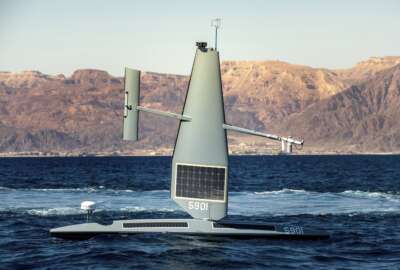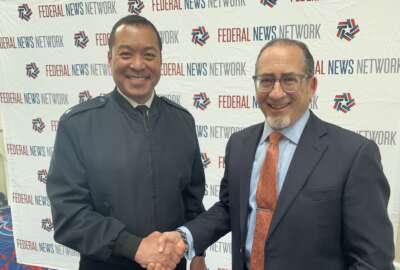
How the Naval War College teaches sailors about dealing with the China threat
The past three administrations have named China as the U.S. top rival, threat. Military leaders model what would happen in a conflict in and around Taiwan.
The past three administrations have named China as the U.S. top rival, threat. Military leaders model what would happen in a conflict in and around Taiwan. At the Sea Air Space conference earlier this week, the Federal Drive with Tom Temin discussed how the Naval War College teaches about the China rivalry when I caught up with professor and retired Navy officer James Holmes.
Interview transcript:
Tom Temin When we talk about China, what’s the official word at the Naval War College? Is it an enemy? Frenemy, rising rival. What is it?
James Holmes That’s an outstanding question, and it sounds like such a simple thing, but it’s something that we talk about a lot. If you go ahead and call China an enemy, in a sense you’re almost foreclosing a lot of options for competing in peacetime, for working with them diplomatically, for doing things. Sometimes we do things with them at sea, such as in the western Indian Ocean, countering piracy. So I personally try to shy away from that word until China gives me no options. I talk about them as an opponent, an antagonist, sometimes adversary, whatever the case may be. So we try to stop a little bit short of that, so as not to create a self-fulfilling prophecy of China basically listening to what we say and assuming that everything else except fighting is off the table.
Tom Temin It’s a big difference from the days of, say, the Cold War when there was not all that much economic interdependence between the Soviet Union and the United States, or for that matter, from Germany of the thirties and forties. Now China and us are totally interdependent, economically, and that’s a complicating factor. Is that something you teach in the background at the War College?
James Holmes We teach two core courses. We have an intermediate level course pitch to mid-grade officers and then a senior level, of course, pitch to senior officers, commanders and captains and their equivalents in the other services. And the senior courses is much more pitched at the grand strategic level where you do talk about a fair amount about economics and things like that. So at the intermediate level, it’s much more focused on warfare, what happens between the time that the shooting starts and the time it stops. But when you kick it up as high as national policy, and people such as we see walking around here in Washington, that’s something you’re going to be bringing in diplomacy, economic statecraft and the other elements as well. And you’re right, it’s absolutely crucial. I’m an old cold warrior myself, and it was it just was not the same thing during between us and the Soviet Union. Which is one reason, it always makes me a little bit leery when we start talking about a Cold War, too, just because it’s very different. China today is not the Soviet Union in 1950 or pick your favorite date.
Tom Temin Yeah. The concept of absolute capacity is a big figure in planning for war, preparing for war. The United States always had the greatest absolute capacity relative to other nations that it conflicted with. China has greater absolute capacity, by maybe a factor of 2 to 3, over the United States. How does that figure into doctrine and teaching and training?
James Holmes We’re always been in the Naval War College. We’re always going back to World War II in the Pacific in particular. Thinking about comparing China as an opponent today to Imperial Japan in 1941 or whatever, your favorite date for the competition is. At that point, the United States had about a nine to 10 to one economic advantage over Japan. And in terms of gross domestic product, we could build a lot more ships and they couldn’t replace their losses very easily. And it’s just a whole different thing with China. China is the biggest shipbuilder in the world, which is one reason they’re building their navy and their merchant fleet up so rapidly and so forth. So you could look at Japan, you could look at the Soviet Union. But yes, just doing all those historical legwork, you just have to think it’s a different situation we’re in today.
Tom Temin And so therefore, you have the strategic offset, which is technologically based and not raw materials, and how many people can we throw in the field based.
James Holmes That’s sort of the other side of the equation. The Soviet Navy was, by the 1960s and certainly into the 1970s, the Soviet Navy always vastly outnumbered us. I mean, the Soviet Navy at one point operated about 300 attacks, submarines, nuclear powered attack submarines and conventional subs. But like you say, on the offset side, it’s not all about material. It’s about the human factor, seamanship, tactics, gunnery, all those sorts of things that people bring to the table. But as a century ago, Admiral Bradley first pointed out in his book, the Navy is a fighting machine. It takes a skilled and motivated user to get 100% of the design performance out of a piece of gear. So we hope that we are better suited to that than China is, even though they’re gaining, in fact they have gained the advantage of numbers in the Navy.
Tom Temin All right. So then really, from the war college standpoint, the Navy, let’s say, has an immediate need, immediate strategy of positioning and so forth and posturing. But then there’s the long- term. Is that pretty much what the Navy War College, the Naval War College is concerned with more than what are we going to do next month?
James Holmes Yeah, I think that’s a pretty fair thing to say. The war colleges, it’s kind of an interesting academic institution, because we’re bifurcated between the war gaming side, the research side, which is more focused on what we are doing right now. How can we do things better today. And then I’m on the academic side, and it’s in our teaching and in our personal writings and so forth. We do tend to take the longer view, just because that’s a different mission from doing war games, we just had the game on contested logistics last week. So that’s a very ripped from the headline topic. So you’re right there’s no single war college view about any of these topics. We try to be an academic place and squabble among ourselves, but I think that’s the drift of opinion.
Tom Temin And again, relative to China, what do you teach in terms of cultural orientation? Because the language is different, the hemisphere is different, the history is different. I mean, it’s almost a different universe inhabited relative to even maybe the Russians and people in Eastern Europe versus the West, as we understand it. Is that part of the curriculum?
James Holmes Yeah, we do it. We do as well as we can. Well, sort of two things, on the on the academic side where I teach, we have a quite a bit of Asia and China content. And the course is reaching all the way back to the Russia-Japanese War of 1904 and 1905 and on up to China, the competition with China today. We do the best we can getting a handle on Chinese history, Chinese culture. We obviously can’t teach Mandarin in the short period, our students were with us. But we do have a core of expertise in Mandarin speakers and East Asian language speakers in the departments who help us find materials that are good in English and so forth. The other side is that since 2006, on the research wing of the of the War College, we’ve had what we call the China Maritime Studies Institute, and these are exclusively Mandarin speakers, and they basically sit and read Chinese documents and think about them and translate them for us every day. That’s really helpful, because then we can then put that back into the academic side and make all of us smarter.
Tom Temin Because many Chinese people do know English. I once was speaking to a class from China. And there was a translator there, and everything I would say they would say in Chinese. And I made a joke. And I said to the translator, I said, don’t translate that. You all got it anyway. They all laughed, so I knew they knew exactly what I was saying before the translator said it.
James Holmes I picked my foreign language in 1982 when the Cold War was going on forever, and the Germans seemed like it would be something that would be everlasting. If I had been able to look 40 years into the future and see what was happening, I might well have gone the Mandarin route myself.
Tom Temin And what is your own background?
James Holmes Well, I graduated from Vanderbilt in 87, was commissioned in the Navy as a surface warfare officer, steamed around in the Battleship Wisconsin for four years. Did the Desert Storm and taught in the Navy, training in education and community. And while I was doing that, I attended the War College in the evening. I just got hooked by all the historical and the theoretical material, and decided to get out of the service and do it from this side of the podium if possible. So I went up to the Fletcher School at Tufts for a Ph.D. My wife and I ended up moving to Athens, Georgia for seven years to work at the University of Georgia. And that provided the platform to get back to Newport in 2007. And here we are.
Tom Temin Interesting. And what is the approach these days of the jointless idea? That’s been around since before either one of us was born, The idea of a joint purple force. It feels like it’s actually starting to be something that’s realized.
James Holmes I think it has to be if we’re going to compete at sea. If you think about what’s what can be done at sea, from platforms, from tactical aircraft or missiles or whatnot, based on land out at sea. There you have an air force, an army and a rocket force that are ground based elements contributing to the fight at sea. So if you’re China, those elements are supplementing the fleet’s efforts at sea, and that could be China’s great equalizer in a fight with ourselves if indeed we remain the superior Navy. But we also have to figure out the name of the joint force that we’re going up against, which is one reason I think you see the U.S. Air Force also taking a big interest in sinking ships, conducting war games and dropping precision minefields and doing all that stuff. So I think our sister services are taking this maritime mission on board. And I think that’s a great thing.
Tom Temin Yeah. In fact, I earlier spoke with a Air Force training officer for Air for Airmen. And he said that there is a piece of technology and an approach that the naval aviation operation is using that the Air Force wants to bring over. I guess there’s no more evidence of purple this than that.
James Holmes Yeah, the Navy, the Air Force and in the aviation communities have taken somewhat different philosophies to its aircraft design over the years. The Air Force has been all in on stealth for the last 30 years. And the Navy has tended to put its confidence more in electronic warfare, more active measures. But now, like you said, I think you actually see sort of a merger of those two things. We’ve moved in their direction and I think they’re coming in our direction as well.
Copyright © 2025 Federal News Network. All rights reserved. This website is not intended for users located within the European Economic Area.
Tom Temin is host of the Federal Drive and has been providing insight on federal technology and management issues for more than 30 years.
Follow @tteminWFED
Related Stories





